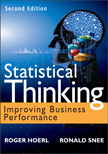Our newest book in the Wiley and SAS Business Series, Statistical Thinking: Improving Business Performance, Second Edition, has been called “probably the most practical basic statistics textbook that has ever been written within a business context.”* It prepares readers for business leadership by developing their capacity to apply statistical thinking to improve business processes.
Why should business leaders know how to use statistical thinking and methods? The authors, Dr. Roger W. Hoerl (who leads the Applied Statistics Laboratory at GE Global Research) and Dr. Ronald D. Snee (President of Snee Associates, LLC; he also serves as an Adjunct Professor at Temple University School of Pharmacy and Rutgers University Department of Chemical and Biochemical Engineering), explain.
Using statistical thinking and methods helps you more effectively and efficiently:
- Deal with the variation inherent in dynamic business processes that drive our economy at home and around the world
- Develop a data-based understanding of business processes and how they work
- Identify and solve problems that keep us from being effective in our endeavors
- Increase the performance of business processes through process improvement frameworks and associated statistical tools
- Collect, analyze and interpret data, that are fundamental to the scientific method
- Design experiments to test new products and different ways of doing things
- Develop a data-based foundation for identifying and modeling cause and effect relationships
- Quantify and reduce variation that leads to reduced waste and increased quality and productivity
- Explore and summarize data producing better understanding and new insights to the phenomena being studied
- Understand the strategic value of data in monitoring, control and improvement of operating processes
 Concentrating on JMP software as the main tool to develop graphics and perform statistical analyses, Statistical Thinking, Second Edition, focuses on skills to enrich business processes, including collecting data appropriate for a specified purpose, recognizing limitations in existing data, and understanding the limitations of statistical analyses.
Concentrating on JMP software as the main tool to develop graphics and perform statistical analyses, Statistical Thinking, Second Edition, focuses on skills to enrich business processes, including collecting data appropriate for a specified purpose, recognizing limitations in existing data, and understanding the limitations of statistical analyses.
Looking for more? Read a free chapter or order your copy today.
*Technometrics, on the first edition